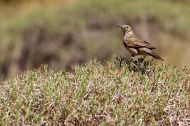Scale-throated Earth-Creeper
Bandurrita Común
Upucerthia dumetaria
Length: 225mm. Sexes alike. Bill brown with proximal half of mandible grey; iris dark brown; forehead, crown, hind neck, upperparts and uppertail coverts greyish brown; the tail has the two central feathers pale greyish brown, remainder of tail feathers are dark brown, the three outer ones on either side are tipped pale cinnamon brown as the edge of the outer rectrices on either side. Eyebrow whitish, throat, neck and breast whitish buff with feathers margined greyish brown imparting a scaly appearance, flanks greyish brown, belly whitish buff; wing coverts greyish brown, primaries and secondaries with base of feathers forming
a broad reddish cinnamon bar while remainder of feathers are brown, undertail coverts buffy brown with whitish margins. Legs brown. Average weight: 55g. Habitat and behaviour: it frequents shrubby regions and bunchgrass almost invariably in pairs or in small groups; very terrestrial, it moves quickly through the thickets. When it flies, it is at low height, often perching in or under shrubs. Not easily mistaken on account of its long and curved bill.
The nest is made in caves or burrows where up to four white eggs are laid. Range: three subspecies of Scale-throated Earth-Creeper occur in Patagonia, namely, Upucerthia dumetaria hypoleuca in Neuquén and west of Río Negro, out of the forested region; Upucerthia d. saturatior in wooded Andean regions of Neuquén, Río Negro and Chubut; Upucerthia d. dumetaria from the pre-Andean region through all the arid regions from Río Negro to Tierra del Fuego.
Illustrated Handbook of the Birds of Patagonia
Kindness: Kovacs Family |










